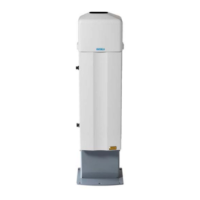USER'S GUIDE____________________________________________________________________
46 __________________________________________________________________ M210482EN-D
Backscatter Coefficient
The volume backscatter coefficient, ß(z), represents the portion of light
reflected back towards the ceilometer from a distance z (for example,
from water droplets). A dense cloud gives a stronger reflection. This can
be expressed as follows:
ß(z) = k·σ (z)
where
k = Proportionality constant [1/srad].
σ
(z)
= Extinction coefficient (the attenuation factor in forward direction)
[1/m].
The extinction coefficient relates to visibility in a straightforward
manner. If visibility is defined according to a 5 % contrast threshold
(World Meteorological Organization definition for Meteorological
Optical Range, MOR, equals daylight horizontal visibility), then the
extinction coefficient is the following:
σ = 3 / V
where
V = MOR visibility (5 % contrast) [m]
The proportionality constant, k, also called the Lidar Ratio, has been
subjected to a lot of research. Although the Lidar Equation can be solved
without knowing the ratio, it must remain constant with the height if
accurate estimates of the extinction (or visibility) profile are to be made.
It has been discovered that in many cases, k can be assumed to equal
0.03, tending to be lower (down to to 0.02) in high humidity, and higher
(up to 0.05) in low humidity conditions. However, in precipitation
conditions, k can have a wider range of values.
Assuming k value of 0.03 srad
-1
, visibility in clouds in the range of 15 to
150 m (50 to 500 ft), gives the following range for β:
β = 0.0006 ... 0.006 m
-1
srad
-1
= 0.6 ... 6 km
-1
srad
-1
Vertical Visibility
Any fog, precipitation, or similar obstruction to vision between the
ground and the cloud base may attenuate the cloud base signal and
produce backscatter peaks that far exceed that from the cloud. Virtually

